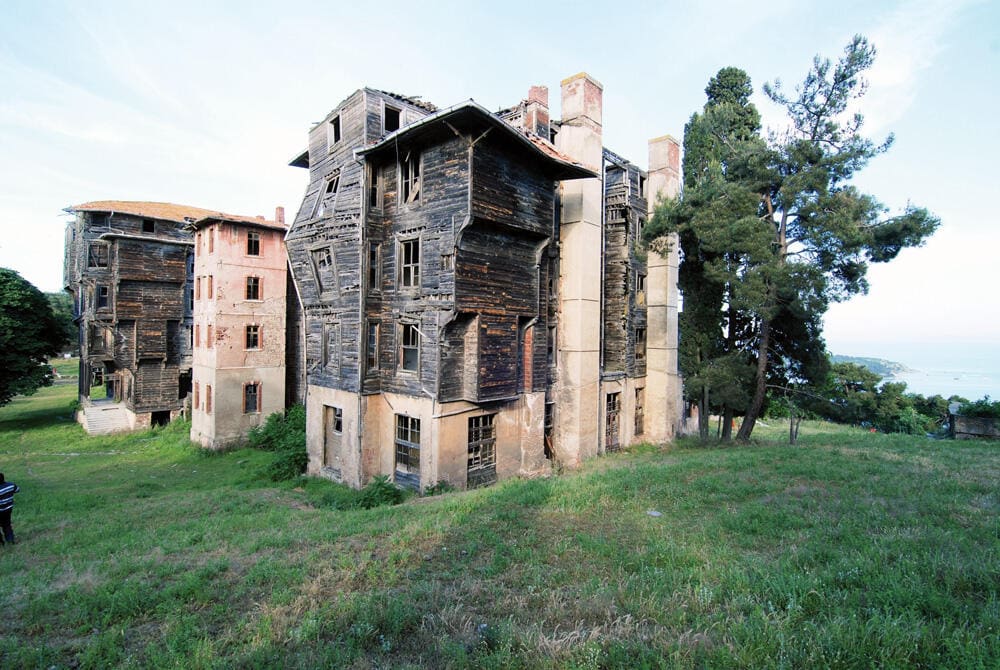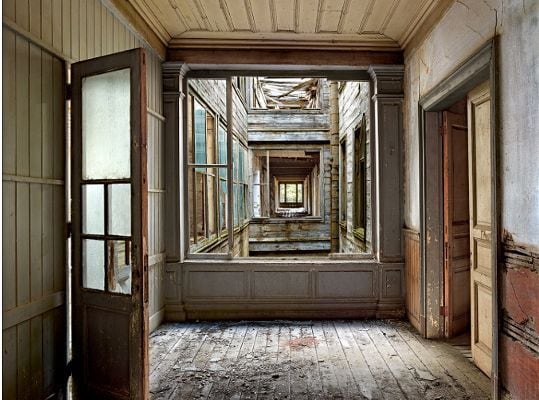
By Uzay Bulut
A restoration of Constantinople’s Prinkipo Greek Orthodox Orphanage would cost at least 40 million euros and would take four to fıve years to complete, according to a recent report by Europa Nostra, the leading European heritage organization, and the European Investment Bank (EIB) Institute.
The orphanage which is located on the Princes' Islands (Adalar) in Turkey, has been empty for decades and is thought to be the largest wooden building in Europe, and the second-largest in the entire world.
Included in the World Monuments Watch list since 2012, the orphanage is currently classified as “Rescue Needed” by the Global Heritage Network. The complex was also listed among the 7 Most Endangered heritage sites in Europe in 2018, following a nomination made by Europa Nostra Turkey.

“The site is currently abandoned to decay,” said the report released on July 29, “an immediate preliminary intervention should be quickly designed, planned and implemented to protect the buildings from further deterioration.”
The historic facility, along with its vast properties, was owned by the Greek Orthodox Church, centered in the Ecumenical Patriarchate, and it cared for orphans since 1902.
But why and since when has it been “abandoned to decay”?
The story of this orphanage represents the severe and continued abuse that Greek people and cultural heritage have for decades suffered at the hands of subsequent Turkish governments.

Push to Save the Historic Orphanage
Like many other properties belonging to Greeks, the orphanage too was seized by the Turkish Foundations General Directorate without compensation in 1997. For years after its seizure, the Ecumenical Patriarchate unsuccessfully instituted legal proceedings in Turkeyto recover the property.
A briefing entitled “The Greek Orthodox Church in Turkey: A Victim of Systematic Expropriation” was held in Washington in 2005 by the Commission on Security and Cooperation in Europe.
Dr. Anthony Limberakis, the then national commander of the order of St. Andrew, Archons of the Ecumenical Patriarchate, was one of the speakers. He said, in part:
“The Ecumenical Patriarchate is the victim of religious persecution by the Government of Turkey. This persecution is systemic, involving multiple levels of government, including local and national, judicial and legislative. It is insidious, occurring over many decades, and devastating, designed to ultimately obliterate the very existence of the Ecumenical Patriarchate.
“The Government of Turkey imposes severe restrictions on the ownership of property by the Ecumenical Patriarchate and of the Greek Orthodox community… It has confiscated thousands of properties of the Greek Orthodox community.
“Stated another way, the Ecumenical Patriarchate and its institutions do not have the right to buy, sell, maintain and inherit properties.”
As a“calamitous example of this process”, Limberakis referred to the expropriation of the Prinkipo Orphanage by the Turkish government. He then showed a picture of some American citizens - Archons and clergymen – “who took the time to leave their families and businesses and comforts of the United States and travel to the Ecumenical Patriarchate and… witness this religious persecution.” Limberakis also noted that they inspected the orphanage property and found it to be “in a state of complete ruin”.
In 2005, the Ecumenical Patriarchate finally filed a legal action against the Turkish Government in the European Court of Human Rights (to which Turkey is a signatory). As the Order of St. Andrew, Archons of the Ecumenical Patriarchate in America noted at the 2009 Organization for Security and Cooperation in Europe (OSCE) conference,
“That process ended on July 7, 2008, with a ruling strongly in favor of the Ecumenical Patriarchate… The Court condemned the Turkish State for improperly taking over the Orphanage and held that the rights of the Patriarchate are protected by international law. The Court also stated that it will revert, in a subsequent decision, to the issue of how the Patriarchate’s rights will have to be restored.”
In 2012, Turkish authorities finally returned the building to the Patriarchate. Mihalis Vasiliadis, editor-in-chief of the Greek daily Apoyevmatini, told the newspaper Hürriyet:
“The state did not return the building to us in the same shape it was in when they [seized] it. The most recent studies have revealed beyond any doubt that millions of euros will be required [to restore the orphanage]. It is not possible for our 2000-strong population to meet this figure.
“Even if officials were to return everything that was historically seized, this would hardly change anything, as the Rum [Greek] community in Istanbul is now almost non-existent. [The Turkish government] took everything from us. The properties’ administrators were exiled, and now they are hastily returning [the properties], but to whom?”
From Constantinople to Istanbul
When the political or cultural history of Constantinople is discussed, many analysts choose to focus on the city’s Ottoman era only. Yet, the history of the ancient city predates the Ottoman Empire by centuries.
Historian Donald L. Wasson explains:
“Built in the seventh century BCE, the ancient city of Byzantium proved to be a valuable city for both the Greeks and Romans. Because it lay on the European side of the Strait of Bosporus, the Emperor Constantine understood its strategic importance and upon reuniting the empire in 324 CE built his new capital there - Constantinople.
“Constantinople would become the economic and cultural hub of the east and the center of both Greek classics and Christian ideals... During the Middle Ages, the city would become a refuge for ancient Greek and Roman texts.”
Constantinople served as “a Christian city of immense wealth and magnificent architecture” and “stood as the seat of the Byzantine Empire for the next 1,100 years,” according to the “History” website.
The city fell to the invading Ottoman Turks on May 29, 1453. Christians and Jews under the Ottoman rule became “dhimmis”, second-class subjects of the empire forced to pay a tax in exchange for so-called “protection.” Despite systematic persecution at the hands of Ottoman rulers, Greeks and other Christians for centuries remained a sizable community across the Ottoman Empire.
However, the last and most destructive blow against Christians took place at the hands of two Turkish regimes – the government of the Committee of Union and Progress (CUP) and the successor Turkish nationalist movement - before, during and after the World War I.
Vasileios Meichanetsidis, a historian and co-editor of the 2011 book “The Genocide of the Ottoman Greeks”, writes that “The genocidal process against the Ottoman Christians constitutes the first massive destruction of citizens by their own government in the modern period… From 1913 to 1923, the Ottoman Greek community was thoroughly destroyed through expulsion, massacre, war, and genocide.”
The process continued even after the establishment of the Turkish republic in 1923 against the remaining Greeks and their institutions. In 1930, Turkeyofficially changed Constantinople’s name to Istanbul. In 1955, Greeks, Armenians and Jews in Constantinoplewere targeted through a pogrom in which their homes, offices, churches and other properties were violently attacked. And in 1964, the remaining Greeks in the city were deported by the Turkish government. They were not allowed to sell their houses or property or to take money from their bank accounts.
Constantinopolitan Greeks, once the founders and rulers of the land, are now estimated to constitute fewer than 2,000 in a city of about 15million.
Turkey’s Moral Duty
The recent report by Europa Nostra and the EIB said that “The Patriarchate, through the final legal owner of the Site, would be responsible for raising the necessary funds for financing the main works and to carry out the implementation of the project” to get the orphanage repaired.
Given the fact that the Turkish government is responsible not only for the almost complete destruction of the orphanage but also for the annihilation of the community that could have taken care of it, it is actually the Turkish government that needs to provide the required funding to prevent the orphanage from collapse and total devastation.
This might sound like an “unrealistic” expectation as Turkey still fails to acknowledge its past and present crimes. More advanced nations, however, do take courageous steps to recognize the rights of those who suffered persecution or violence. Portugal and Spain, for instance, have enacted laws to grant citizenship to descendants of Sephardic Jews exiled 500 years ago. The laws aim “to atone for the state-led campaigns of persecution against the Jews in the 15th and 16th century known as the Spanish and Portuguese Inquisition.”
For the orphanage and other Greek properties in Turkey to properly operate, Turkey too should grant dual (Turkish) citizenship to the descendants of the Greeks and other Christians that were murdered or expelled by Turkey.
Only then will Turkey have taken a first, historic and meaningful step to provide transitional justice for the victims of its appalling human rights abuses.
About the author: Uzay Bulut is a Turkish journalist and political analyst formerly based in Ankara. Her writings have appeared in various outlets such as the Gatestone Institute, Washington Times, Christian Post and Jerusalem Post. Bulut’s journalistic work focuses mainly on human rights, Turkish politics, and history, religious minorities in the Middle East and anti-Semitism. Bulut has now also become a contributor for the Greek City Times.


